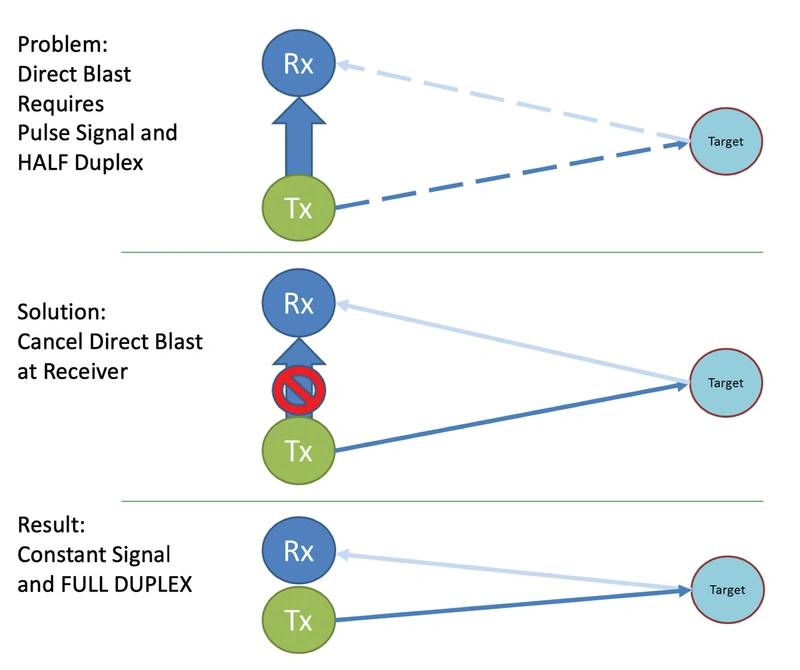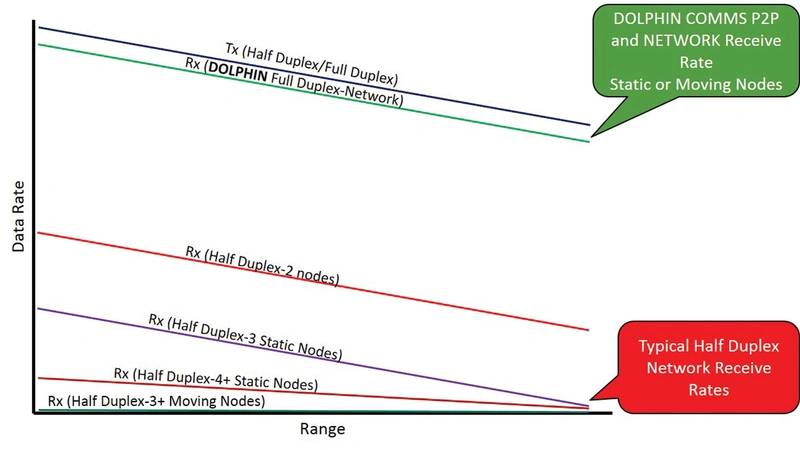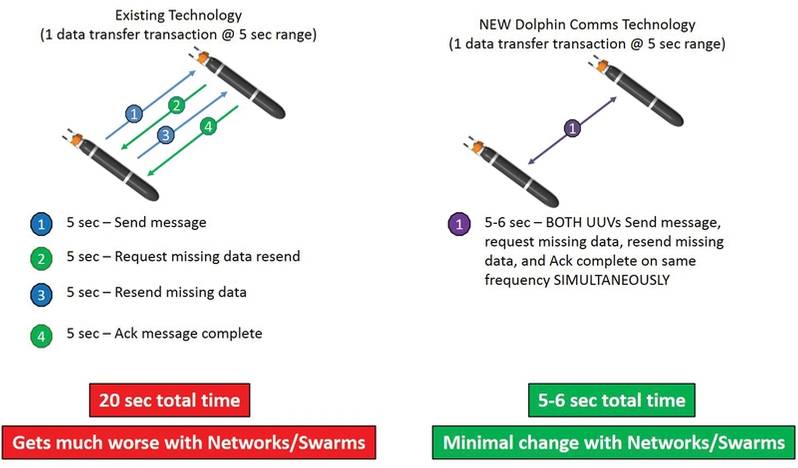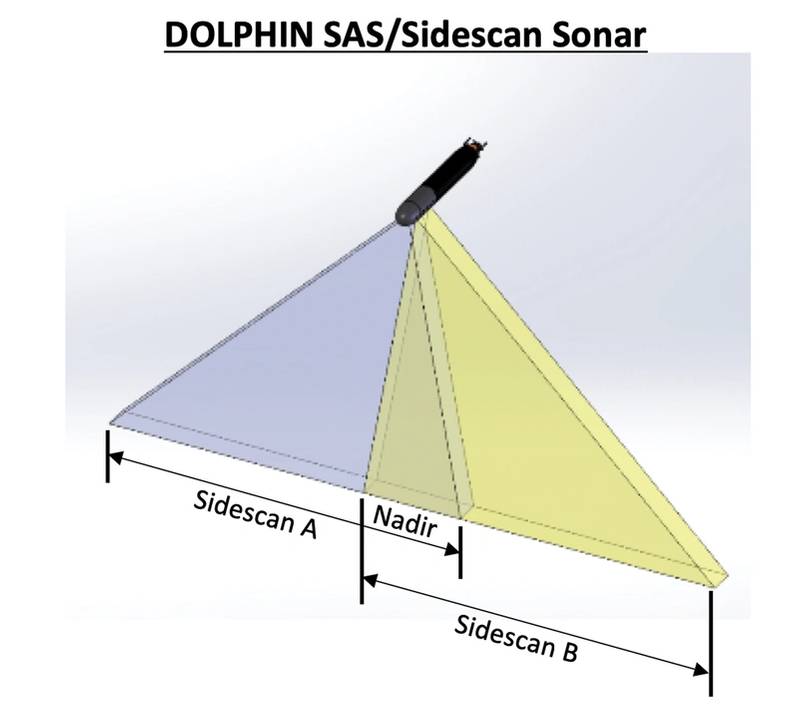
DOLPHIN: Enabling Technology for Acoustic Systems
DOLPHIN Signal Processing Technology
Acoustics enable many core undersea capabilities. Where radio waves do not propagate well, and light is absorbed quickly, acoustic signals help us map, see, locate and communicate. The many products and technologies that employ acoustics all depend upon signal processing, thus new processing approaches can impact many applications. QinetiQ North America (QNA) and its partner Optimal Systems Laboratory (OSL) have developed DOLPHIN - a patented method using analog cancellation that eliminates receiver saturation and enables simultaneous transmit and receive. Figure 1 describes this concept.
 Figure 1: The basic concept of DOLPHIN. Image: QinetiQ North AmericaApplication to Underwater Telemetry
Figure 1: The basic concept of DOLPHIN. Image: QinetiQ North AmericaApplication to Underwater Telemetry
Since the beginning of acoustic communications, the state of the art technology has been limited to half-duplex signals: transmit with the receiver off and then turn the transmitter off and receiver on and wait to receive, because the direct transmission at the source saturates the receiver electronics if they are enabled simultaneously.
Ocean physics are fixed, but DOLPHIN technology enables true full-duplex acoustic telemetry. It cancels the transmit signal at the receiver in real-time. This eliminates receiver self-signal saturation and enables simultaneous transmitting and receiving on the same frequency, with collocated transducers. The DOLPHIN technology is frequency and range independent - thus yielding flexible new approaches to underwater communications and sensors.
In practice, the impact of full duplex comms vs standard half duplex comms can be viewed in terms of the change in data throughput (speed of receipt of meaningful information). This can be generically viewed in terms of data rate vs range. Figure 2 shows a generalization of the benefits of DOLPHIN Comms vs traditional approaches.
 Figure 2: DOLPHIN Receive Rate vs. Conventional Receive Rates. Image: QinetiQ North America
Figure 2: DOLPHIN Receive Rate vs. Conventional Receive Rates. Image: QinetiQ North America
The positive benefits are particularly clear as the number of nodes in a half-duplex (mobile or static) network increase. While increasing nodes degrades the overall throughput of conventional, half-duplex networks, modeling and testing show that DOLPHIN Comms networks will maintain consistent performance. This is even more evident in networks of moving nodes where half-duplex networks generally cease to function with more than two nodes. But full-duplex networks of more than two moving nodes are possible and maintain high data throughput. This demonstrates the value of the DOLPHIN Comms technology in enabling networks of moving nodes, like swarms of UUVs.
A more concrete example of the benefits can be seen by considering the case of two UUVs attempting to communicate using Assured Data Communications. This is depicted in Figure 3. Traditional half-duplex approaches require an acknowledgement from the receiving node for each packet that is sent and take 20 seconds, in this example, to deliver a data message between UUVs. But using a DOLPHIN full-duplex approach can deliver up to a 400% improvement of throughput. To be clear, this improvement is entirely due to the signal processing approach, the overall limitations of acoustic transmission remain. Or to put it a bit casually, while the laws of physics have not changed, DOLPHIN Comms provides better lawyers.
 Figure 3: Data Throughput Improvements for UUV Case Study. Image: QinetiQ North AmericaApplication to Mapping Sonar
Figure 3: Data Throughput Improvements for UUV Case Study. Image: QinetiQ North AmericaApplication to Mapping Sonar
This same technology can be applied to side-scan sonar (SSS), a very common tool for seafloor mapping and survey, and synthetic aperture sonar (SAS) an emerging technology. Typically, SSS presents a “gap” in the coverage it offers, as in Figure 4. This gap, or “Nadir” separates the left side sonar from the right to avoid interference.
Because DOLPHIN enables transmission and reception of many signals in the water column simultaneously it allows for coverage to overlap. As shown in Figure 5, one set of signals, Sidescan A, is ensonifying a portion the same area as Sidescan B. In traditional sonar applications this would result in interference and lost data. But with DOLPHIN processing it is possible to interpret both signals and thus fill the nadir gap as in Figure 5.
This provides full swath coverage of a SSS or SAS with no gap. In fact, the forward scatter from either sidescan (A or B) can be used by the other sidescan (B or A) to improve the resolution in the area that both sides overlap.
In addition to the obvious benefit of improved coverage, DOLPHIN processing can provide other advantages to sonar systems including increased resolution and adaptability to environmental concerns such as marine mammal safety.
 Figure 4: Typical Side-scan displays a gap in coverage. Image: QinetiQ North AmericaLab and Field Testing
Figure 4: Typical Side-scan displays a gap in coverage. Image: QinetiQ North AmericaLab and Field Testing
DOLPHIN Comms and Sonar proof-of-concept (POC) demonstrations have been successfully completed. In tank and harbor trials, previously reported upon, DOLPHIN Comms delivered successful results. The system was able to demonstrate 65+ dB of analog cancellation in a highly reverberant, laboratory tank. Following tank trials, the development program moved to open water. This test included omni directional transducers, realistic frequencies and bandwidths, useful range distances, in highly reverberant conditions. The test demonstrated 80 dB of analog cancellation in a difficult and dynamic environment and the ability to scale to useful distances using commercial equipment, while maintaining robust, reliable full-duplex communications. The test was performed at 6% power (60 mW or 160 dB) and demonstrated its expected 1.6 Kbits/sec data rate, full-duplex telemetry.
In sonar testing DOLPHIN has also shown promise. To date work has modelled 100% reconstruction of an image (nadir filling) and demonstrated DOLPHIN SSS and SAS in a laboratory environment. It has also demonstrated DOLPHIN SONAR operation in a laboratory environment with prototype equipment. The test case to date has used a 3 meter tank at 1 meter range with a 2 MHz frequency.
In addition, QNA has demonstrated the ability of the DOLPHIN SAS to be able to exceed the typical SAS Nyquist speed limitations. Conventional SAS can only advance as fast as the Nyquist speed, based on the specifications of the SAS. If one exceeds the Nyquist speed, the conventional SAS image fails completely. With a DOLPHIN SAS, one can exceed the Nyquist speed without losing signal. As a result, the image will gracefully degrade (blur) the more the sonar exceeds 2x the Nyquist speed. In other words, DOLPHIN SAS can at least double the standard SAS speed. It can even increase the speed, albeit with an increasing blurry image. Figure 6 was created in a test tank with a simple DOLPHIN SAS operating at 3x the Nyquist speed.
In 2018 QNA was awarded a contract from the Naval Surface Warfare Center, Panama City Division, (NSWC PCD), Panama City, FL to demonstrate advanced, low power, sidescan sonar technology. Phase 1 is complete and results will be presented in future publications.
 Figure 5: Two sonar swaths overlapping with DOLPHIN™ processing fill the typical nadir gap. Image: QinetiQ North AmericaPractical Applications
Figure 5: Two sonar swaths overlapping with DOLPHIN™ processing fill the typical nadir gap. Image: QinetiQ North AmericaPractical Applications
The DOLPHIN processing technology can be applied to communications, sonar, and telemetry systems. In practice this will yield benefits to many markets and applications. Military operations will benefit from networking, clandestine communications, improved throughput, and increased tolerance for difficult acoustic conditions. One could envision DOLPHIN enabled networks of unmanned systems more quickly and reliably finding and neutralizing mines in deep waters and in the surf zone. Commercially the oil and gas, and to a lesser extent offshore renewables, are looking to seafloor resident systems for both installation and inspection, maintenance and repair (IMR). These underwater applications will benefit immensely from the utility, position navigation and timing (PNT) and data connectivity, taken for granted by mobile devices connected to conventional satellite and radio networks.
These markets will also benefit from improved sonar. Mine hunting coverage rates will increase with faster sonar advance speed and the systems will not have to survey twice to fill the SSS/SAS “gaps.” Energy infrastructure will be quickly mapped to support operations and maintenance needs. Ocean science and exploration will benefit from increased mapping coverage rate. DOLPHIN will improve upon limited ocean mapping coverage to date.
DOLPHIN Comms is a transformational technology that enables full duplex acoustic underwater communication and improved sonar systems. The technology has been validated in field trials. There are ongoing applications and development projects planned in defense applications.
Commercial and scientific applications and trials are of great interest. While the core technology is ready, the many layers of product and “system of systems” developments will evolve over time. A robust ecosystem of hardware manufacturers, software developers and end users must mature around the underlying, enabling technology. With appropriate, collaborative effort, it is reasonable to assume that many products and applications will become DOLPHIN enabled.
Author Biographies
Justin Manley is a technologist and executive with experience in startup, public corporation, academic, and public sectors. After professional roles at MIT, supporting NOAA and in the private sector he founded Just Innovation Inc. in 2015 to support a variety of clients with a focus on unmanned and undersea systems.
Michael Murphree is the Communications and Surveillance Technology Manager for Maritime Systems at QinetiQ North America. Michael has a wealth of experience in undersea systems engineering, software and automation as well as his current work with acoustic communications.
Greg Folts is Director of Business Development for Maritime Systems at QinetiQ North America. He has over 30 years experience in unmanned systems and mine warfare as an engineer and a program manager for the US Navy. Greg has been engaged in the private sector defense community, with a focus on unmanned systems and sonar technology since 2007.
Read DOLPHIN: Enabling Technology for Acoustic Systems in Pdf, Flash or Html5 edition of April 2019 Marine Technology
Other stories from April 2019 issue
Content
- AIS Data: History & Future page: 10
- DOLPHIN: Enabling Technology for Acoustic Systems page: 20
- Unheard Underwater: Covert Communications page: 26
- World Navies: Brazil´s Riachuelo Submarine page: 34
- French Frigate Sonars Get an Upgrade page: 38
- Efficient Wave-Generated Power … Really! page: 40
- SUBSEA ENGINEERING: By-pass, superfast page: 48


